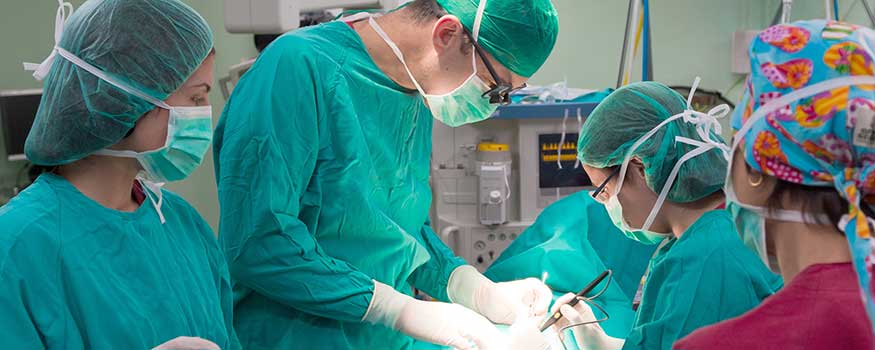When Brenda Ulmer, MN, RN, CNOR, worked in the operating room (OR) full time, she was aware of the seemingly fleeting smoke that was produced during certain surgical procedures, but didn’t link it to how she felt at the end of the day.
It wasn’t until switching to a per diem schedule— with many days off in between—that she noticed a striking pattern. After working a shift, she headed home with a headache, sore throat, and chest congestion. On her days off, she was symptom-free.
Ulmer pinpointed the source of her symptoms to that surgical smoke.
“I could really feel what it did to my body,” said Ulmer, who helped develop an Association of periOperative Registered Nurses (AORN) education and award program focused on the hazards of surgical smoke to healthcare professionals and patients. AORN is an organizational affiliate of ANA. In spring 2016, AORN announced the launch of its 3-year, national Go Clear Award™ program, and now is engaged in a full-court press to assist nurses, other surgical team members, and hospital administrators in implementing practical, evidence-based solutions to end this workplace threat.
“We have smoke-free restaurants, airports, and hospital grounds,” said Vangie Dennis, BSN, RN, CNOR, CMLSO, director of Patient Care Practice at The Emory Clinics: Ambulatory Surgery Center in Atlanta, GA, and AORN member. “But many hospitals continue to allow staff to be exposed to surgical smoke.”
The hidden hazards
Smoke, or plume, is created when lasers or other surgical, energy-generating devices are used to cauterize vessels, destroy tissue, or cut bone, according to AORN. These instruments are used in millions of procedures annually.
The amount of smoke produced and its composition is concerning.
“When you use energy devices, such as lasers and electrosurgical devices, tissue is heated to temperatures of 100° C or higher,” said Mary Ogg, MSN, RN, CNOR, senior perioperative practice specialist at AORN and long-time OR nurse. “The tissue vaporizes and gaseous products are produced.”
“Within that smoke can be harmful chemicals, such as benzene and toluene; viruses, including HIV and human papillomavirus; bacteria; blood; and cancer cells,” Ogg noted. Although the long-term health effects of being exposed to surgical smoke are still unknown, many respiratory problems and other short-term effects are evident. In addition, some 150 chemicals have been identified in surgical plume and linked to health issues ranging from acute and chronic respiratory conditions to liver and kidney damage to potentially leukemia.
Looking at some statistics, the smoke produced when using an electrosurgical device on 1 gram of tissue is the equivalent of inhaling the smoke from 6 unfiltered cigarettes in 15 minutes, according to AORN. The average daily intake of surgical smoke by the OR team is similar to inhaling the smoke from 27 to 30 unfiltered cigarettes.
Perioperative nurses Ogg and Ulmer pointed to other statistics to emphasize the importance of the Go Clear Award campaign. The Occupational Safety and Health Administration (OSHA) reported that roughly 500,000 healthcare workers are exposed to surgical smoke annually. In a survey conducted by the National Institute for Occupational Safety and Health released in 2015, nearly half of 4,500-plus respondents said they never had training on the hazards of surgical smoke, and one third said that local exhaust ventilation, which is used to control smoke, was not part of their workplace protocol.
The plume’s reach
AORN estimates that 160,000 perioperative nurses are exposed to surgical smoke. However, this hazard extends well beyond the surgical suite.
When working in inpatient ORs, Dennis recalled nurses smelling smoke wafting into preop and post-op areas, which meant staff there, as well as patients and family members, were at risk.
“It also occurs in labor and delivery during C-sections, in interventional radiology and dermatology clinics, for example,” Ogg added.
Nicholas Golda, MD, medical director of University of Missouri Health Care’s dermatology clinics, performs eight to ten surgeries a day, and until recently, worked amid smoke. Golda said he had an epiphany about the hazards of surgical smoke while working with a colleague on an occupational safety review.
“I didn’t want to have an issue with my health, because I was ignorant of this hazard,” said Golda, who used research from AORN and other sources to successfully convince his administration to purchase specialized equipment, such as tubing that attaches to electrocautery pencils to capture and filter smoke.
“Of all the process and quality improvements we have done in our practice, the nursing staff and I agree that this has been the most impactful thing we’ve done to improve our daily work experience.”
Currently, Golda is embarking on research exploring dermatology surgical teams’ attitudes about surgical smoke and another study looking at patient satisfaction, including understanding their experiences with surgical smoke, which has been described as smelling like burning hair.
“In our culture, the patient is at the center of every decision we make,” Golda said. “So we are conducting research to determine how interventions, such as intraoperative smoke evacuation, impact the patient experience in our clinics.”
Achieving a smoke-free environment
The AORN Go Clear program is a comprehensive approach to protecting patients and workers by promoting a surgical smoke-free environment and recognizing healthcare settings that succeed in achieving that goal. Components of the free, 10-step program include testing the perioperative team’s knowledge, conducting a gap analysis looking at surgical smoke levels and current smoke evacuation equipment, intraprofessional education, and compliance monitoring. The program offers many resources, including tools to conduct a gap analysis and evaluate smoke evacuation products. Facilities can earn Go Clear designations at three levels, all lasting 3 years.
So far, 85 facilities nationwide have registered to participate in the Go Clear program, and 110 have requested more information.
“Emory absolutely embraced the program,” said Dennis, who noted that Emory beta tested Go Clear. “Having smoke-free equipment doesn’t interfere with the surgical process. So we need to get to a tipping point where other facilities embrace surgical smoke-free environments.”
Added Ogg, “This is an important program because it provides nurses with the research-based information they need to make the healthcare environment safer for nurses and patients.”
AORN also is asking all nurses to advocate for an OSHA regulation recognizing surgical smoke as a workplace hazard.
The program manual is available on request. Additionally, AORN developed a “Guideline for Smoke Safety,” which is adaptable to all areas where operative and other invasive procedures are performed. It was published in the 2017 Guidelines for Perioperative Practice in January.
The Go Clear Award campaign is sponsored by Medtronic through the AORN Foundation.
Susan Trossman is a writer-editor with ANA.


















